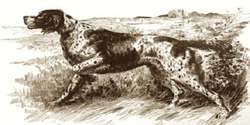Copy of `Canine Genetics`
The wordlist doesn't exist anymore, or, the website doesn't exist anymore. On this page you can find a copy of the original information. The information may have been taken offline because it is outdated.
|
|
|
Canine Genetics
Category: Animals and Nature > Dog genetic terms
Date & country: 25/01/2011, UK
Words: 38
|
Allele frequencythe fraction of all the alleles of a gene in a population that are of one type.
Allelesdifferent versions of the same gene (found at the same locus but in homologous chromosomes or in different individuals) that may produce different phenotypes.
Assortative matinga mating scheme that relies on the pairing of unrelated individuals with similar phenotypes to obtain consistency of type and reinforce desirable traits.
Codominant allelestwo alleles that have different effects that are distinguishable in a heterozygous individual (e.g. AB blood groups)
Cross-breedingcrossing two different breeds.
Dominant alleleone that determines the phenotype even when there is only one copy (i.e. in a heterozygous individual).
Driftchanges in allele frequencies over time due to chance (as opposed to selection or mutation).
Effective population size (Ne)the size of a hypothetical stable, randomly-mating population that would have the same rate of gene loss or increase in inbreeding as the real population (size N). As all finite populations are inbred to some degree and generally do not choose mates at random, Ne is typically 1/10 N or less, particularly if fewer males breed than females.
Epistasisused to describe the situation where one gene's expression prevents the expression of another (e.g. you cannot determine whether an albino would have had black or brown hair, though these two traits are controlled by separate genes.)
Fitness (relative)The reproductive success of individuals of a particular genotype relative to the most fit genotype.
Fixationloss of all alleles of a gene but one.
Founderan individual drawn from a source population who contributes genetically to the derived subpopulation.
Founder effectchanges in allele frequencies that occur when a subpopulation is formed from a larger one. Typically many rare and usually undesirable alleles are excluded while a few carried by the founders get a big boost in frequency.
Founder equivalentsthe number of hypothetical founders that would have the same diversity as the descendant population. Generally much smaller than the actual number due to unequal use and allele loss (gene dropping).
Genethat portion of the genome that carries the information for a single protein. (In cases of proteins with multiple subunits, there may be a gene for each.)
Gene droppingloss of alleles due to genetic drift.
Genetic bottleneckwhen population numbers are temporarily reduced to a level insufficient to maintain the diversity in the population.
Genetic diversityusually expressed in terms of percentage of genes that are polymorphic and/or are heterozygous.
Genomethe total genetic makeup of an organism.
Heritabilitythe fraction of the variability in a trait that is caused by genetic differences.
Heritablepassed on from parents to progeny through the chromosomes/DNA.
Heterosisa situation where crossing two inbred lines yields progeny that are more healthy/vigorous than their parents. (More commonly used in plant breeding.)
Heterozygouscarrying two different alleles of a gene.
Heterozygous advantagea situation where the heterozygous genotype for a particular gene shows the highest relative fitness.
Heterozygous insufficiencywhen the heterozyous genotype lacks sufficient gene product to have the normal phenotype. (Approximately equivalent to partial dominance.)
Homologous chromosomesin higher plants and animals, chromosomes are found in nearly identical "homologous" pairs, one coming from the sire and the other from the dam. A dog has 39 pairs, or 78 in total. Only one of each, chosen at random, is passed on through eggs or sperm to the progeny.
Linebreedinga scheme that attempts to maintain a high contribution of one or two ancestors through successive generations. Often used by breeders for any inbreeding less intensive than between first-degree relatives.
Linkagea measure of how frequently two genes found on the same chromosome remain together during gamete (egg or sperm) formation.
Locusthe location of a gene on a chromosome.
Map (aka linage map)a drawing showing the location of and relative distances between genes on a chromosome.
Mean kinship (mk)a measure of how related an individual is to the other members of a population. Generally computed as the average IC for the hypothetical progeny of the individual mated to all other members of the population (both sexes). A low average mk for a population indicates that most of the diversity carried by the founders has been retained.
Monomorphic geneshave only one common allele (rare alleles with frequencies of less than 0.001% may still occur).
Mutationa change in the sequence of the base pairs in a DNA molecule.
Mutation ratethe number of new mutations that occur per gene per gamete per generation.
Outcrossingmating two individuals of the same breed that are sufficiently unrelated that the IC of the progeny is lower than the average of the parents.
Polymorphic geneshave 2 or more common alleles in the population.
Recombinant frequency (RF)how often two linked genes are separated by recombination, generally expressed as a percentage of total progeny.
Recombinationthe reciprocal exchange of portions of two homologous chromosomes (usually equivalent) during gamete formation.

